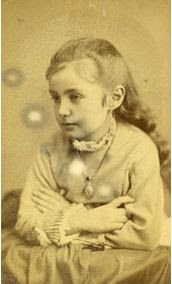William Ayres Simpson was born in New Hampshire in 1812. After working in Boston and Detroit, he
moved to Sandusky
in 1834. In Sandusky,
William Simpson was a partner of Horace Aplin in the grocery business. Later he
was engaged in business ventures with Leonard Johnson and David Everett. Mr.
Simpson was a stockholder and director in the Sandusky Gas Company, and served as its
president for many years. He was also a stockholder and director in the Second
National Bank.
Mr. Simpson was a member of Grace Episcopal Church for over forty years, serving on the church vestry
for thirty-six years. Following his death on December 20, 1887,
his former pastor, Rev. Dr. S.
A. Bronson wrote in a letter, “Mr. Simpson was a man with as many virtues, and
as few faults, as almost any one who can be found in this crooked world. As a
vestry man in my church during the sixteen years I was rector of Grace Church, Sandusky, I can safely say
I found no fault in him. As a business man, he was honest and honorable; as a
Christian, and as an Officer of the church, he was faithful is the discharge of
all his duties; benevolent, judicious and wise. If help was needed, he was
always ready to do his part. He was always a pillar in Grace Church," and
he adds, "a thousand more words in all departments of life may be said of
him." Rev. R. L. Howell, another
former Grace rector, stated in the book History of Erie County, Ohio, that “William A.
Simpson was one of those rare instances of the happy commingling of solid worth
and simplicity of character which it is positively refreshing to behold.”
On January 5, 1841, William A. Simpson married Mary A.
Denman.
Mary’s parents, David and Mary Wright Denman died when she
was only age two. She was adopted by Major John G. Camp, who was a friend of
Mary’s father. Mr. and Mrs. Simpson did not have children of their own, but
they raised two adopted daughters. One adopted daughter was Eliza D. Bartlett,
who was the daughter of Mary Simpson’s sister; the other child was born Jane
Eliza Marsh, to Cornelius and Rebecca Marsh. After her parents died in the
cholera epidemic of 1849, Mr. and Mrs. Simpson raised her, calling her Jennie
E. Simpson.
Mary A. Simpson died on March 8, 1911. In her obituary, which
appeared in the March 9, 1911 issue of the Sandusky
Register, she was referred to as “a woman of generous impulses. Mrs.
Simpson found great pleasure in giving for almost every good work.” Among the
gifts that Mrs. Simpson presented to Grace Episcopal Church were the parish house, at the corner of Adams and Hancock Streets,
and the east transept window of the church, which features “The
Feast of the Epiphany.” Mrs. Simpson also left monetary gifts to Calvary Church,
the Women’s Guild of Grace Episcopal Church, Kenyon
College, Providence Hospital,
and several others.
Mr. and Mrs. William A. Simpson were very generous to the community
of Sandusky. To
read more about this couple, there are several sources available, including
History of the Western Reserve, At Home in Early Sandusky, and History of Erie County, Ohio.
Mr. and Mrs. William A. Simpson are buried in the North Ridge section of Oakland Cemetery.

 this blog
this blog
































